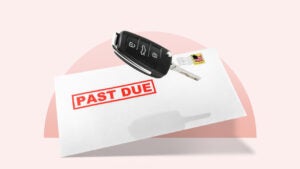Auto loan delinquency rates expected to return to normal

While vehicle prices have been going up, auto loan delinquency rates have remained surprisingly low for the first two years of the pandemic.
Unfortunately, this is no longer the case. As the Federal Reserve works to address growing inflation, more borrowers are falling behind on their auto loans — and we can expect delinquency rates to return to pre-pandemic levels as we near the end of 2022.
2022 delinquency rates continue to rise
The strong credit trends during the pandemic are returning to normal levels, exemplified by auto loan performance this month. According to Cox Automotive’s weekly insight from early October, loans more than 60 days delinquent have been increasing — up 30.8 percent from a year prior.
But normal does not necessarily mean good. As these numbers show, rates of delinquency are inching higher each coming month — especially for subprime drivers.
Subprime borrowers are those most directly affected by inflation and likely can be vulnerable to lenders. Currently, it is vital to stay up to date on your loan payment to avoid the risk of defaulting on your loan and losing your vehicle.
The good news is that these increased delinquencies have not yet led to an increased number of drivers defaulting on their loans at pre-pandemic levels. But vehicle availability and access to credit will likely shift the landscape as 2022 comes to an end.
Focus on the big picture
While it is true that delinquency rates are on the rise, it is important to consider the factors that are driving this increase. Due primarily to an issue of supply and demand which remains the main influence of price increase in the automotive industry. With lower inventory and higher demand, more expensive vehicles mean higher rates, 6.58 and 11.70 percent, for new and used cars respectively, according to Experian.
But Satyan Merchant, senior vice president and automotive business leader at TransUnion, warns to look at the big picture when it comes to auto delinquencies following the “Critical Eye on Auto Performance, released in mid-October.
Merchant notes that, “while point-in-time delinquency rates are elevated when compared to prior periods, we have observed fairly stable vintage performance.” So, this increase in delinquency is normal when viewed on a larger economic scale. The report also found that general performance was similar to 2019 rates, an encouraging sign.
A shrinking “denominator”
Another influential factor in rising delinquency rates is something TransUnion calls, “the shrinking denominator,” This relates to the number of vehicles that are being financed — much lower than previously. This is driven by fewer originations in 2020 which continued decline due to limited vehicle supply and then an increase in vehicle repossession in both 2021 and 2022.
These factors have combined to create an “imbalance between origination volumes and total account runoff results in lower total outstanding account volume,” found TransUnion.
What kept auto loan delinquency rates steady?
Data from February 2022 indicates that government assistance helped play a key role in keeping delinquency rates steady over the past two years. Because many of the Americans receiving extra assistance during this time also fall under the subprime category, it meant lower loan originations and delinquency rates.
Missing loan originations
Across the board, most auto delinquencies come from borrowers with low credit scores. So, with fewer low-credit borrowers getting new loans, delinquency rates remained fairly low. Many low-credit borrowers did not finance new loans due to less demand for a vehicle with stay-at-home orders and more stringent acceptance criteria implemented by lenders.
The findings following the recent Fed meeting reinforce this assumption. Much of the end of 2020 and start of 2021 were made up of a lower number of loan originations. These “missing originations” — as the Fed described them — meant fewer delinquency rates. If drivers that tend to fall subject to repossession or defaulting on their loans are not borrowing, fewer delinquencies will occur.
This combined with federal assistance and lenders extending leniency on payments, meant fewer delinquent loans and originations.
How to avoid falling behind on your auto loan
The new car market is hot right now so buying used can be a good option to save money. But if you decide to take out a loan with a shorter term, then it is usually wise to make a large down payment to avoid unmanageable monthly payments.
Also, if it becomes challenging to make your monthly payment, consider refinancing your loan. Keep in mind that extending your term also increases the amount of interest you pay over the life of the loan.
By purchasing a used vehicle, drivers can own a high-quality vehicle at a much lower price. And, since new cars depreciate quickly in the first year or two, you’re more likely to avoid becoming underwater on the loan — owing more than it’s worth.
The bottom line
Delinquencies have been low through the first two years of the pandemic. The primary reasons for the lower rates of default are fewer borrowers, and more government assistance for borrowers who would normally have issues making payments.
With assistance ending and more people in search of vehicles — and by extension, financing — there will likely be a steady increase in delinquencies over 2022. But this is more a representation of the end of federal support, and not necessarily cause for alarm.
Learn more
- Compare auto loans with Bankrate
- Ideal situations to refinance a car loan
- How to get a car loan with bad credit
Why we ask for feedback Your feedback helps us improve our content and services. It takes less than a minute to complete.
Your responses are anonymous and will only be used for improving our website.
You may also like

Car loans for students: What to know





